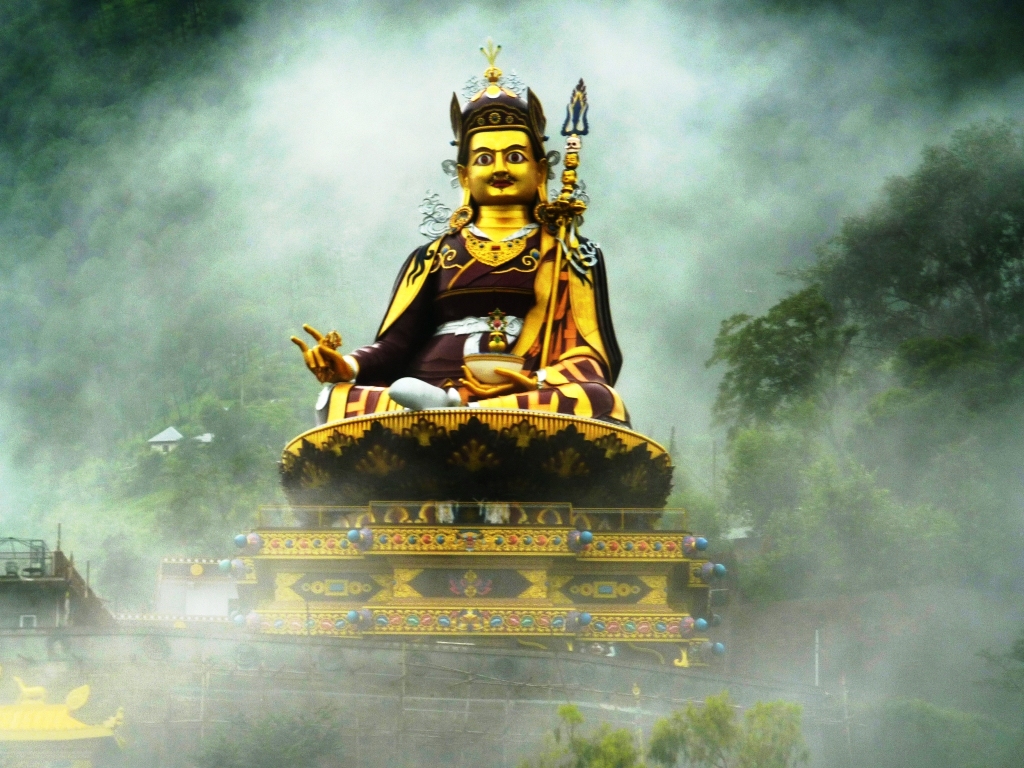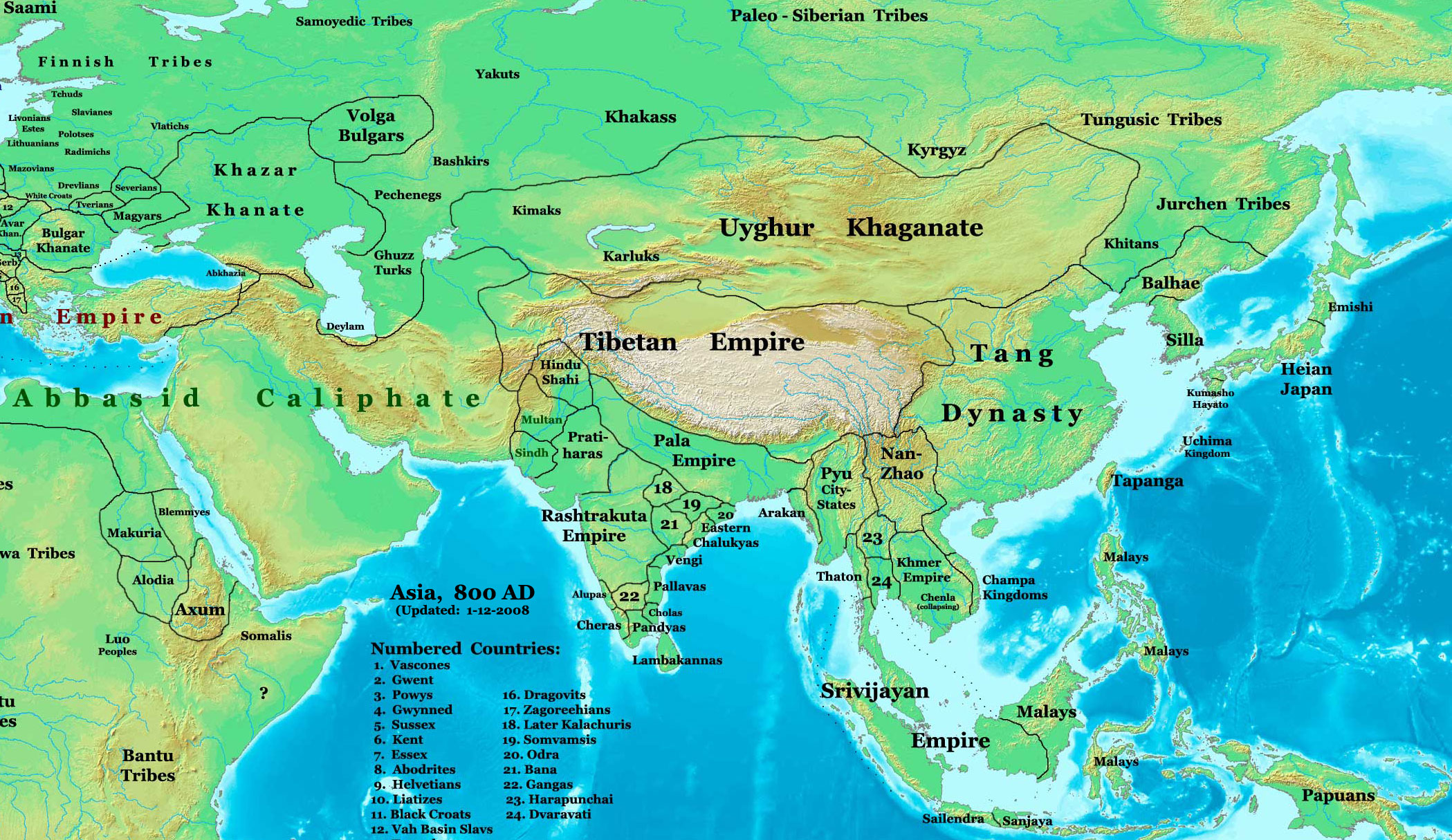 |
Samye
Samye (, ), full name Samye Mighur Lhundrub Tsula Khang (Wylie: ''Bsam yas mi ’gyur lhun grub gtsug lag khang'') and Shrine of Unchanging Spontaneous Presence is the first Tibetan Buddhist and Nyingma monastery built in Tibet, during the reign of King Trisong Deutsen. Shantarakshita began construction around 763, and Vajrayana founder Guru Padmasambhava tamed the local spirits for its completion in 779. The first Tibetan monks were ordained there. Samye was destroyed during the Cultural Revolution then rebuilt after 1988. Samye Monastery is located in the Chimpu valley (''Mchims phu''), south of Lhasa, next the Hapori mountain, in the Yarlung Valley. The site is in the present administrative region of Gra Nang or Drananga Lhoka. History According to the Blue Annals, completed in 1476, the temple was constructed between 787 and 791 under the patronage of King Trisong Detsen. Earlier in date is the Testament of Ba, the oldest account of the construction of the temple. Th ... [...More Info...] [...Related Items...] OR: [Wikipedia] [Google] [Baidu] |
|
Shannan, Tibet
ShannanThe official spelling according to (), also romanized from Tibetan as Lhoka (; ), is a prefecture-level city in the southeastern Tibet Autonomous Region, China. Shannan includes Gonggar County within its jurisdiction with Gongkar Chö Monastery, Gonggar Dzong, and Gonggar Airport all located near Gonggar town. Located on the middle and lower reaches of the Yarlung Valley, formed by the Yarlung Tsangpo River, Lhoka region is often regarded as the birthplace of Tibetan civilization. It is bounded by the city of Lhasa to the north, Nyingchi to the east, Shigatse on the west and the international border with India and Bhutan on the south. The city measures east to west and from north to south. Its uniqueness stems from the fact that Tibet's earliest agricultural farmland, its first palace and first Buddhist monastery are all located in Lhoka. It also has the distinction of having held the first lhamo performance. Ethnic Tibetans constitute 98% of the population, the rema ... [...More Info...] [...Related Items...] OR: [Wikipedia] [Google] [Baidu] |
|
 |
Padmasambhava
Padmasambhava ("Born from a Lotus"), also known as Guru Rinpoche (Precious Guru) and the Lotus from Oḍḍiyāna, was a tantric Buddhist Vajra master from India who may have taught Vajrayana in Tibet (circa 8th – 9th centuries)... According to some early Tibetan sources like the ''Testament of Ba'', he came to Tibet in the 8th century and helped construct Samye Monastery, the first Buddhist monastery in Tibet. However, little is known about the actual historical figure other than his ties to Vajrayana and Indian Buddhism. Padmasambhava later came to be viewed as a central figure in the transmission of Buddhism to Tibet. Starting from around the 12th century, hagiographies concerning Padmasambhava were written. These works expanded the profile and activities of Padmasambhava, now seen as taming all the Tibetan spirits and gods, and concealing various secret texts ('' terma'') for future tertöns. Nyangral Nyima Özer (1124–1192) was the author of the ''Zangling-ma'' (Jew ... [...More Info...] [...Related Items...] OR: [Wikipedia] [Google] [Baidu] |
.jpeg/1200px-Tibetan_Buddhism_(214837929).jpeg) |
Tibetan Buddhist
Tibetan Buddhism (also referred to as Indo-Tibetan Buddhism, Lamaism, Lamaistic Buddhism, Himalayan Buddhism, and Northern Buddhism) is the form of Buddhism practiced in Tibet and Bhutan, where it is the dominant religion. It is also in majority regions surrounding the Himalayan areas of India (such as Ladakh, Sikkim, Arunachal Pradesh, and a minority in Himachal Pradesh and Uttarakhand), in much of Central Asia, in the southern Siberian regions such as Tuva, and in Mongolia. Tibetan Buddhism evolved as a form of Mahāyāna Buddhism stemming from the latest stages of Indian Buddhism (which also included many Vajrayāna elements). It thus preserves many Indian Buddhist tantric practices of the post-Gupta early medieval period (500 to 1200 CE), along with numerous native Tibetan developments. In the pre-modern era, Tibetan Buddhism spread outside of Tibet primarily due to the influence of the Mongol Yuan dynasty (1271–1368), founded by Kublai Khan, which had ruled China, M ... [...More Info...] [...Related Items...] OR: [Wikipedia] [Google] [Baidu] |
.jpeg/1200px-Tibetan_Buddhism_(214837929).jpeg) |
Tibetan Buddhism
Tibetan Buddhism (also referred to as Indo-Tibetan Buddhism, Lamaism, Lamaistic Buddhism, Himalayan Buddhism, and Northern Buddhism) is the form of Buddhism practiced in Tibet and Bhutan, where it is the dominant religion. It is also in majority regions surrounding the Himalayan areas of India (such as Ladakh, Sikkim, Arunachal Pradesh, and a minority in Himachal Pradesh and Uttarakhand), in much of Central Asia, in the southern Siberian regions such as Tuva, and in Mongolia. Tibetan Buddhism evolved as a form of Mahāyāna Buddhism stemming from the latest stages of Indian Buddhism (which also included many Vajrayāna elements). It thus preserves many Indian Buddhist tantric practices of the post-Gupta early medieval period (500 to 1200 CE), along with numerous native Tibetan developments. In the pre-modern era, Tibetan Buddhism spread outside of Tibet primarily due to the influence of the Mongol Yuan dynasty (1271–1368), founded by Kublai Khan, which had rul ... [...More Info...] [...Related Items...] OR: [Wikipedia] [Google] [Baidu] |
|
Trisong Detsen
Tri Songdetsen () was the son of Me Agtsom, the 38th emperor of Tibet. He ruled from AD 755 until 797 or 804. Tri Songdetsen was the second of the Three Dharma Kings of Tibet, playing a pivotal role in the introduction of Buddhism to Tibet and the establishment of the Nyingma or "Ancient" school of Tibetan Buddhism. The empire Tri Songdetsen inherited had declined somewhat from its greatest extent under the first Dharma King, Songtsen Gampo. Disintegration continued when, in 694, Tibet lost control of several cities in Turkestan and, in 703, Nepal broke into rebellion. Meanwhile, Arab forces vied for influence along the western borderlands of the Tibetan empire. Nevertheless, Tri Songdetsen became imperial Tibet's greatest ruler and an unparalleled Buddhist benefactor. Tri Songdetsen and his support for Buddhism Tri Songdetsen is very important to the history of Tibetan Buddhism as one of the three 'Dharma Kings' (Tibetan:''chögyel'') who established Buddhism in Tibet. The Th ... [...More Info...] [...Related Items...] OR: [Wikipedia] [Google] [Baidu] |
|
 |
Śāntarakṣita
(Sanskrit; , 725–788),stanford.eduŚāntarakṣita (Stanford Encyclopedia of Philosophy)/ref> whose name translates into English as "protected by the One who is at peace" was an important and influential Indian Buddhist philosopher, particularly for the Tibetan Buddhist tradition . Śāntarakṣita was a philosopher of the Madhyamaka school who studied at Nalanda monastery under Jñānagarbha, and became the founder of Samye, the first Vihāra, Buddhist monastery in Tibet. Śāntarakṣita defended a synthetic philosophy which combined Madhyamaka, Yogachara, Yogācāra and the Buddhist logico-epistemology, logico-epistemology of Dharmakirti into a novel Madhyamaka philosophical system .Blumenthal (2018) This philosophical approach is known as ''Yogācāra-Mādhyamika'' or ''Yogācāra-Svatantrika-Mādhyamika'' in Tibetan Buddhism. Unlike other Madhyamaka philosophers, Śāntarakṣita accepted Yogācāra doctrines like mind-only (''cittamatra'') and self-reflective awarenes ... [...More Info...] [...Related Items...] OR: [Wikipedia] [Google] [Baidu] |
 |
Nyingma
Nyingma (literally 'old school') is the oldest of the four major schools of Tibetan Buddhism. It is also often referred to as ''Ngangyur'' (, ), "order of the ancient translations". The Nyingma school is founded on the first lineages and translations of Buddhist scriptures from Sanskrit into Tibetan in the eighth century, during the reign of King Trisong Detsen (r. 710–755). Nyingma traditional histories consider their teachings to trace back to the first Buddha Samantabhadra (Güntu Sangpo) and Indian mahasiddhas such as Garab Dorjé, Śrī Siṃha and Jñānasūtra. Traditional sources trace the origin of the Nyingma order in Tibet to figures associated with the initial introduction of Buddhism in the 8th century, such as Padmasambhava, Yeshe Tsogyal, Vimalamitra, Vairotsana, Buddhaguhya and Shantaraksita. The Nyingma tradition is also seen having been founded at Samyé, the first monastery in Tibet. Nyingma teachings are also known for having been passed down through ... [...More Info...] [...Related Items...] OR: [Wikipedia] [Google] [Baidu] |
 |
Odantapuri
Odantapuri (also called Odantapura or Uddandapura) was a prominent Buddhist Mahavihara in what is now Bihar Sharif in Bihar, India. It is believed to have been established by the Pala ruler Gopala I in the 8th century. It is considered the second oldest of India's Mahaviharas after Nalanda and was situated in Magadha. Inscriptional evidence also indicates that the Mahavihara was supported by local Buddhist kings like the Pithipatis of Bodh Gaya. The ''vihara'' perished at the hands of Muhammad bin Bakhtiyar Khalji, a Turko-Muslim invader in the late 1100s, when he launched multiple raids on Bihar and adjoining territories. Location Joseph David Beglar first identified the city of Bihar (Bihar Sharif) with Odantapuri; as the city used to be called ''Bihar Dandi'' or ''Dand Bihar'', which is a contraction of ''Dandpur Bihar'' (derived from "Dandpura Vihara"). A small brass image of the goddess Parvati, bearing a votive inscription on the back that mentioned the name ''Uddand ... [...More Info...] [...Related Items...] OR: [Wikipedia] [Google] [Baidu] |
 |
Testament Of Ba
''The Testament of Ba'' (Tibetan or ; Wylie transliteration: or ) is an account written in Old Tibetan of the establishment of Vajrayana Buddhism in Tibet and the foundation of the Samye Monastery during the reign of King Trisong Detsen (r. 755–797/804), reputedly as recorded by Ba Salnang (Tibetan or ; Wylie transliteration: or ), a member of the king's court. The earliest known versions of the text are two manuscript fragments dating to the 9th or 10th centuries that are held at the British Library. Versions of the text The ''Testament of Ba'' was transmitted in manuscript form over many centuries, and so there are many different recensions of the text, but not one single, canonical printed version. Two early versions of the text have been identified by scholars: * A manuscript in 31 folios discovered in Lhasa in 1997, titled (with a 'd' prefix to the Ba clan name), that is thought to be a revised copy of an 11th-century manuscript, and which was published in facsimi ... [...More Info...] [...Related Items...] OR: [Wikipedia] [Google] [Baidu] |
.jpg) |
Lhasa Prefecture
Lhasa is a prefecture-level city, one of the main administrative divisions of the Tibet Autonomous Region of China. It covers an area of of rugged and sparsely populated terrain. Its capital and largest city is Lhasa, with around 300,000 residents, which mostly corresponds with the administrative Chengguan District, while its suburbs extend into Doilungdêqên District and Dagzê District. The consolidated prefecture-level city contains additional five, mostly rural, counties. The city boundaries roughly correspond to the basin of the Lhasa River, a major tributary of the Yarlung Tsangpo River. It lies on the Lhasa terrane, the last unit of crust to accrete to the Eurasian plate before the continent of India collided with Asia about 50 million years ago and pushed up the Himalayas. The terrain is high, contains a complex pattern of faults and is tectonically active. The temperature is generally warm in summer and rises above freezing on sunny days in winter. Most of ... [...More Info...] [...Related Items...] OR: [Wikipedia] [Google] [Baidu] |
|
Tulku
A ''tulku'' (, also ''tülku'', ''trulku'') is a reincarnate custodian of a specific lineage of teachings in Tibetan Buddhism who is given empowerments and trained from a young age by students of his or her predecessor. High-profile examples of tulkus include the Dalai Lamas, the Panchen Lamas, the Samding Dorje Phagmos, the Karmapas, Khyentses, the Zhabdrung Rinpoches, and the Kongtruls. Nomenclature and etymology The word སྤྲུལ or 'sprul' (Modern Lhasa Tibetan ) was a verb in Old Tibetan literature and was used to describe the བཙན་པོ་ btsanpo ('emperor'/天子) taking a human form on earth. So the ''sprul'' idea of taking a corporeal form is a local religious idea alien to Indian Buddhism and other forms of Buddhism (e.g. Theravadin or Zen). Over time, indigenous religious ideas became assimilated by the new Buddhism; e.g. ''sprul'' became part of a compound noun, སྤྲུལ་སྐུ་'sprul.sku' ("incarnation body" or 'tülku', and 'bt ... [...More Info...] [...Related Items...] OR: [Wikipedia] [Google] [Baidu] |